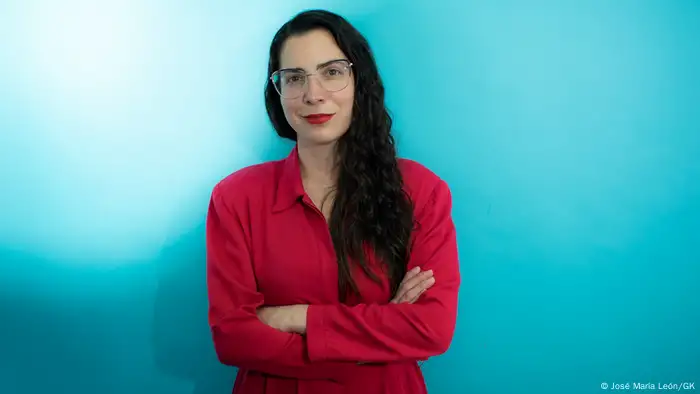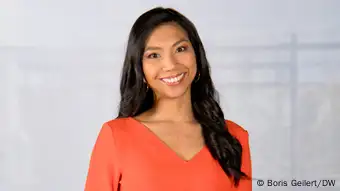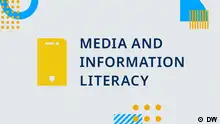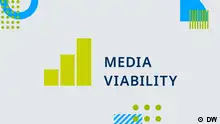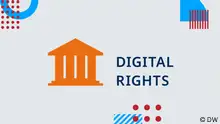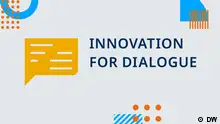Podcast
Isabela Ponce of GK.city, Ecuador: How to survive and thrive with a focus on environmental journalism | The Media Viability Podcast E08 Transcript
For the eighth episode of "Survive and Thrive," our guest is Isabela Ponce, co-founder and editorial director of GK.city from Ecuador. Read the episode transcript here.
Welcome to "Survive and Thrive," DW Akademie’s dialogue with media managers on innovative and sustainable business models in a challenging global media landscape. We'll talk motivation, lessons learned, funding models, best practices, recipes for success and decisions – good and bad.
Watch here, or read the complete transcript below
Janelle Dumalaon (host): If you're a media manager nearly anywhere in the world, then you would be familiar with a multi-faceted challenge of creating a sustainable financial future for your outlet while maintaining relevance for your audiences on a daily basis, all while staying safe and sane.
Given that, it's helpful for media producers to learn from each other and ask how we can be the best versions of our media institutions.
I would like to introduce Isabela Ponce, who is the Chief Editorial Officer and co-founder of GK.city.
That's a digital media outlet in Ecuador focusing on accountability, gender and environment, all with a human rights-centered approach. Eager to get into it with you, Isabela. But first, this quick questionnaire.
Isabela, what is your business model in a catch phrase?
Isabela Ponce: I would say diversify and innovate.
Did you ever manage a moment when everything seemed lost?
Yes, of course, more than once.
What would you need to survive in the future – thrive even?
I would say core investment or core grants, which are not so common. Also, a more profound expansion of our content studio called GK Studio into other Latin American countries, not only in Ecuador.
As we said earlier, we're talking about what it means to survive and thrive. And you've already alluded very briefly to the fact that's not always so easy. Tell us a bit more about your outlet's focus, reminding again our viewers that your focus is on environment and gender and accountability. Can you tell us how you've been covering this with your outlet?
We don’t do breaking news. We do explanatory journalism in various formats – so not only a text or a video or an infographic. With each content, as small as it looks, we try to explain and give knowledge to our audience but not like plain information because we think that's no longer something that we can compete with in the age of Twitter and so many social media platforms.
We always give an added value. We try to explain the "why," not the "what." Why did something happen. What is the backstory? And we apply that not only to short explanatory texts, but also to profound reports or investigations, always trying to give something further for our readers.
The guiding idea being that the facts are out there and it's important for you to go beyond these facts and offer your readers a bit more. I would like to hear more about how you handle these thematic overlaps between environment and gender, for example?
I think when you have, like, a gender focus in your journalism it’s just part of what you do. It influences for instance which sources you decide to interview, who are your main characters and which are the stories you want to tell.
We don’t mention it all the time: "Here, we’re talking about gender. We’re talking about women." It’s more about seeing it in a natural way and looking deeper, for example, into environmental issues or social and environmental problems or leadership. There’s a lot of female leadership, for instance.
I can give you one example: If we are making these stories about a community in the Amazon region that is fighting against an oil company, and you look indeed who are the leaders – they might be women. And then you start investigating and understanding how they managed to have that kind of leadership, taking into consideration the cultural context that isn’t easy for them in a country like Ecuador.
So, when you have that focus it comes naturally. And we try to be as natural as possible for our audience, as well. We don’t say, "These women are doing this or that." We just try to focus on their leadership and what is happening in environmental protection or so.
I would say, the three verticals are always coming together: women, environment and accountability – because you can't separate them.
How much of an impact does your reporting have on, for example, indigenous female leaders in the Amazon? Is this reporting that gets back to them, that impacts their lives, or is it more about bringing it to a wider audience within Ecuador who might not have realized how their lives look like?
I would say both. In their communities, in their territories, they also need their voices to be heard. Telling their stories and having the people that live around them realize how important their work is, that's one thing.
But the other part is raising awareness about the specific topics with a wider audience. Even though GK has this more specific focus, we are explanatory and for that have a wider audience. It’s not a niche, it’s national. We’re bringing topics to the table that usually – if you think about a newspaper – would end up on the second or third page. We’re trying to publish stories that were not so much considered before in traditional media outlets because we think they are important.
How do you choose your stories?
We have a process, it's like a filter, that has to do with relevance and the aim to be innovative. I said before that that is part of our business model, but I think it applies to the whole company. The questions are: How can we add something new to this? Why is it interesting? Why do we want to tell that story?
I can mention a specific story that actually I wrote a few years ago. It was about climate change, as the big underlying topic. And you know, it's so important but also hard to understand. How do we get a broader audience to be interested in that topic? We could talk about it, and we all know the theory: mitigation, adaptation. But I asked: How can we make that a story? Because we work with stories. We don't work with themes or topics. We want to tell the story of one person that can explain a bigger problem, a bigger context.
So, in this case, we told the story of four women who were adapting to climate change in a specific area. And that story had a lot of impact because it went into detail on how they struggled daily with climate change – with extreme weather, like no rain or a lot of rain.
And this is what we always do when we choose to tell a story: We’re always iterating and trying to find the details because we do storytelling. It’s narrative journalism. Sometimes people misunderstand what we mean by explanatory. We try to have a very attractive piece because our goal is to have an audience that can really engage and maybe even change a bit. For instance, the next time they're buying a carrot in the supermarket, they can think about who harvested it and whether she struggled to do it.
I know it sounds like a long shot, but we really try to do that.
It is quite interesting what you say about the importance of detail and of showing and not telling. It is, however, important to realize as well that especially narrative journalism, environmental journalism, forms of journalism that require you to travel, that require you to get to know the people in your story in depth and follow them for a while – these are not easy stories to produce, and they're often associated with great expense. It is expensive to produce in-depth journalism.
Now earlier you said you had a diversified business model. Perhaps you can tell us a little bit more about that diversified business model and how it is financing these important stories that you do that, as we said are quite complicated to produce, especially in the comprehensive way that you try to do them.
Yeah, of course. And yes, it is really expensive. I think this needs to be said because when someone reads the story, they usually have no idea what's behind it.
But yeah, GK has a diversified business model. Our major revenue source is a content agency called GK Studio that generates 50% to 60% of our revenue.
Then we have a membership model – not a subscription, really more like a membership – where our most loyal readers support our journalism.
We also offer workshops and trainings, we call this GK School. We organize open workshops but also partner with different organizations that want to promote specific topics, e.g. illegal fishing in the Galapagos Islands.
We built a project with Internews, gave the trainings, and then gave a few small grants to selected participants so they can produce a story. We call this editorial companionship and we do this for one, three, maybe six months and then we publish a story on GK. It's a very organic project that we’ve done maybe five times now with GK school.
Then, there’s also advertisement in GK but a different kind of advertisement. Traditional advertisement is no longer a thing. So, we do sponsored content or content marketing. We also partner with specific brands or organizations to produce a specific project.
Then we also work with other media around the world, so like for instance in environmental journalism with Mongabay Latam which is focused specifically on the environment.
And we also have grants but those are small and project grants. So, five or six different revenue streams and they're moving all the time. We aim for the pie to be more balanced but that’s not always easy. We are trying to be more innovative, too, for example when it comes to advertisement. We will create a product that we like from the editorial point of view, but where we also know it can be funded by a specific partner who is interested in that.
And the last part, just for these stories, we usually have small grants. For example, for the one about the women in the desert we had a grant from a Colombian university that allowed us to be in the field for seven days. So, when we want to do this more in-depth or long, you know travelling to the Amazon is very expensive and we try to find partners for that because otherwise it's not possible.
The diversification of the business model is something that many outlets have had to do in order to survive and thrive. As we've been saying, it is very important to not be reliant on a single source. On the other hand, the more sources of funding or the more diverse your sources are, the bigger the list of goals that you have to service. How do you balance these different goals? With all your funding sources, how do you make sure that your team is able to accomplish them every single day?
The key to that is very defined roles and processes. It sounds very generic, but it's not. You need to really understand what it means to have specific roles, objectives and specific key performance indicators. Also, having those indicators isn’t enough. You need to go back and measure them, check if what you are doing is working or not, and be able to identify things that can be improved.
I think running an independent media outlet requires that reflection a lot. I’m also a consultant – I'm actually part of DW Akademie’s Media Viability Ambassadors – and we talk about this a lot: How to identify which is the best business model for each media will depend on the region, on the team, on the context. We have had a lot of discussions about this because while contexts are very diverse, you need to find the thing that can differentiate yourself from others. At the baseline, you really need a different idea from others. Sometimes, when you see new media launching, they have the same idea as others and it makes you wonder: Where are they going? Where's their audience? Why are they doing this? Why are they not thinking further about what need from the audience they can respond to? I think that's something that you need to ask yourself a lot and repeatedly.
You’re constantly in this process of negotiation with your goals, negotiation with your output, negotiation with what you can realistically achieve at this time and with the resources that you have.
I wanted to go back to what you said earlier about GK Studios and how that makes up the bulk of your funding, more than half. What is it exactly and what lessons do you think that can teach other new media outlets? What have you learned from having this business model, GK Studio in particular, that you think would be interesting for other media outlets to know?
The main idea that we started with in 2015 is bringing some know-how from the media to the content studio. That could be storytelling, the human rights focus, the graphic quality, whatever.
We are now working a lot with companies and brands that want to talk about their sustainability programs, their sustainability ideas. A few years ago, we also worked with a lot of NGOs, UN agencies that want to produce their communication campaigns. We, for example, did a reproductive rights campaign for people with disabilities. A specific topic that's very hard to communicate and we helped them to build key messages and a graphic design for the campaign. We were a good fit for that because we have this human rights focus, gender focus, and we were able to bring that to their campaign.
So, we have a specific team that works on that. And, answering your question, you can really organize the different processes so that they don't overlap. But I would also say there is the idea of working together in an organic way in which for instance if we develop a specific campaign for a client, one part of the campaign can be sponsored at GK. It benefits all – that's kind of the goal to help provide for the whole operation.
The idea is that you have a specific skill set that you can apply to this one arm of your business, which is the content creation model that you described, where you help brands, for example, with their sustainability or health campaigns. And that in turn helps to finance the separate journalism arm of your operations.
You've talked a bit about how you have the specific teams, you have specific people on separate teams and so doing that keeps the work separate and autonomous from each other, like from these two arms. But do you have any sort of rules that you maintain to prevent overlaps that you don't want?
Yeah, of course. This is why we have different heads for each area. Obviously, we need to talk all the time. And there is a set of rules.
So, if a client asks for something to appear in the media, for instance, like "I want you to do this coverage," the people from GK Studio could give out my or my colleague Susana’s number – but we try not to, for that not to be a conflict.
You've described it very well, like how you got to this point, the decision-making process that you undertake and all these, of course, have shaped the outlet that you have today.
However, when we were talking earlier, remember during our lightning round, you did allude to moments of feeling lost or challenged and perhaps at some point you were even close to giving up.
How did that look like and how did you overcome it in the end?
One of these moments was when we relied too much on one client. It was a client of GK Studio and it was huge, a big project. I think it was more than 50% of the revenue and then the client’s business crashed and we lost it. We were in a very dark place like ‘what do we do, how do we address it?’
It took us a few months to recover by continuing with our other clients, trying to close more contracts with other clients and diversifying. But at that time, it was very difficult. But the thing about this is, you no longer will make the same mistake. You learn a lot. And whenever you start seeing something similar, it’s like: "Red flag! Remember 2015/2016 - don’t do that again!"
Not to focus on the negative or anything, but when we speak of security threats or dangerous coverage in your journalism, what are we speaking about exactly when it comes to Ecuador?
Until three years ago, I would have said something general like the risk of going to the Amazon and knowing that the plane can crash. Or maybe you are in the Amazon region and you can't come back because it has rained for three days and you’re cut off.
But in the past three years, it has become awful: Killings, death threats. We’re recording this on October 31 and so far in 2023, nine journalists have had to flee the country or their cities because of threats to their lives. The majority of these threats comes from organized crime groups. I can't say it's a new problem, but it's a problem that has reached us in the hardest and deathliest way. Last year, there were two or three journalists murdered. And in 2018 we had also three journalists murdered.
Ecuador wasn’t considered a dangerous or violent country before, so it's a shifting environment. And you know, as citizens we need to address it and know what to do and how to act. But as journalists, it's like a double and triple threat.
This year, there was a presidential candidate that was murdered and that was also something that is still a shock and how does this affect us as journalists? Actually, the candidate was a former journalist and he was doing a political rally. We are there all the time, covering elections, covering these events. So we have that kind of risk and we have also the risk coming from people who feel harmed or threatened by what we are publishing. And they might threaten or kill you.
This year has been really, really rough for us because we have been talking for 40 minutes about viability, sustainability, impactful stories, etcetera. Obviously, that matters. But now you have this other thing to worry about and it is not even a separate thing. You have to think about safety with every coverage that you do. You need to be aware of the risks, even if you’re not reporting about violence or such.
We do live in an uncertain environment right now.
Journalists have to be aware of the risks but at the same time, they also should keep their big goals in mind. The job is important. The stories you’re reporting on are important and they have to get out. It's why you do them. Are there any practical things that you do or that you've changed about your behavior or your team's behavior to keep each other safe?
Yes, of course. You mentioned the importance of publishing a story. I would say there's no story that is worth a life. That is our mantra. That's the most important thing.
I haven't mentioned this before but this year we’ve had to extract a journalist from our newsroom for that kind of threat and afterwards we did two specific measures. I can’t go into detail for safety reasons but we kind of think twice about what we are publishing and try not to include specific details that can affect someone. As a journalist, this is hard. Many people would describe it as self-censorship, but I don't think it's self-censorship when you're protecting lives.
We’re also trying to incorporate into the whole organization, not only the newsroom, specific safety measures in the office. Again, I can’t go into detail, but it’s changing small processes or small things that you were used to like inviting guests into the newsroom. That’s not safe anymore because then people know what your office looks like. It requires a lot of talking and a lot of understanding and it's hard when you don't want to admit that you now live in a country where you have to take care of those things.
Psychologically that can be hard: You know it's important but you don't want to admit it at the same time. Making our team think that way with everything they do is now part of our organizational culture.
We're heading toward the end of our podcast, but I think you've done a really good job of illustrating what it means to be a media outlet like yours. You are juggling this multifaceted challenge. We talked about the security challenges that have become more associated with your work. The challenge of producing quality output on topics that are very, very complex, like gender environment accountability with a human rights focus. And of course, the challenge of making sure that your operations are sustainable for the future, financially and in practice.
So, here's a question where you could help other media outlets around the world: Do you have three best practice tips for us given, you know, the enormity of these challenges and the answers that you have found so far?
Yes. I mentioned one before which is very clear roles and processes. I don’t mean thinking about specific people with name and last name, but having the profile, you know, what do you need for certain tasks. And having specific processes because without them it will be a mess, like "been there, done that."
And then – we haven't talked about this so much – but clear financials. You have to know the real costs of your projects of what you're doing in order to build a budget. Obviously for me you need a specialist for finances and we have someone on our team and I don't know what we would do without her. She's the best. So, budget thoroughly. Usually, people do not add things like electricity or internet or the use of your computers or this kind of invisible costs to their budget. Try to really understand the importance of having a clear financial plan and budget. Try to understand your profit margins, you know, because as I mentioned, you will need to grow. It’s not like you want to keep a five-people team forever. So, you need to know your real costs, your profit margin and maybe try not to be scared about it.
And the third thing, I would say, is more related to your identity. What defines you as a media? Have this very clear and don’t be scared to check it every once in a while. Something might be improved or added. You know, you won't lose your essence, but you have to be relevant the whole time so you should be ready for changes.
Reiterating your three best practice tips and let's see if I got them all correct. One: Have very clear rules and specific processes. The second one is about understanding your financials, know your real costs and have someone on your team with financial expertise. And three: Have a clear identity and do not be afraid to check it once in a while to see if it is still commensurate to your operation and the needs and benefits of your audience.
So, at this stage we do have to leave it here. But thank you so much Isabela for coming on to the show today. Isabela Ponce, co-founder of GK.city.
This transcript of episode eight of "Survive and Thrive: The Media Viability Podcast" has been lightly edited for clarity.
Get in touch
For questions and suggestions write to dw-akademie.surviveandthrive@dw.com
Or find us on Twitter, Facebook, LinkedIn and Youtube.
This podcast is produced by DW Akademie and is supported by the Federal Ministry for Economic Cooperation and Development (BMZ).
Isabela Ponce is currently participating in DW Akademie's Media Viability Ambassadors project. Since 2018, GK.city has further been participating in the Tierra de Resistentes project, supported by DW Akademie.
More on Media Viability
Earlier podcast episodes
WWW links
- Date 25.11.2023
- Keywords DW Akademie, media viability, survive and thrive, podcast, Media Management, media business, business model, transcription, revenue, environmental journalism, Reporting on Climate Change, climate change, environment
- Feedback: Send us your feedback.
- Print Print this page
- Permalink https://p.dw.com/p/4ZL3q
- Date 25.11.2023
- Keywords DW Akademie, media viability, survive and thrive, podcast, Media Management, media business, business model, transcription, revenue, environmental journalism, Reporting on Climate Change, climate change, environment
- Send us your feedback.
- Print Print this page
- Permalink https://p.dw.com/p/4ZL3q

